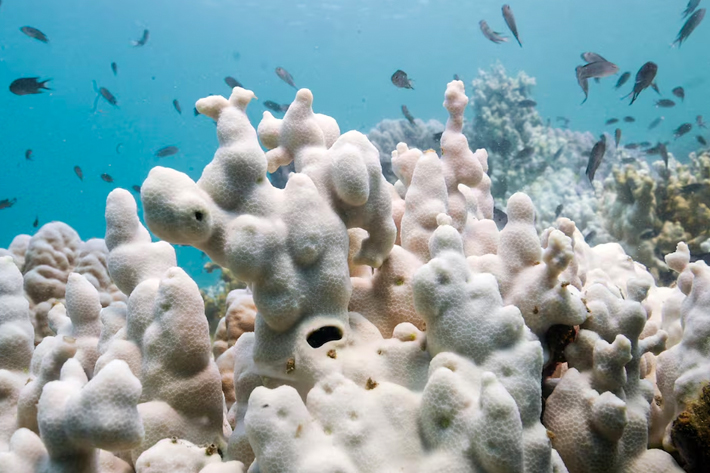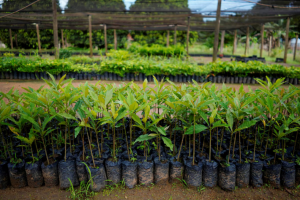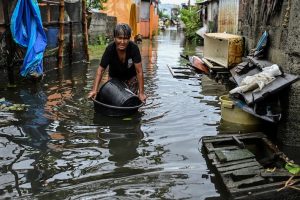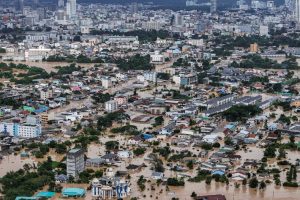Delegates from nearly 200 nations will meet in Cali, Columbia on Monday for COP16 – a two-week UN biodiversity summit – and officials are hoping the summit could lead to a pledge that will combine the world’s nature and climate goals.
While countries have traditionally discussed global climate efforts separately from biodiversity, leaders are increasingly looking at ways of addressing goals for both simultaneously.
After all, the two issues – climate change and nature loss – are deeply interrelated. Safeguarding nature helps to curb climate change, while global warming is also destroying biodiversity and driving extinctions.
Also on AF: Hundreds of Billions for Climate Change Seen as ‘Realistic Goal’
Global warming, for instance, has heated the oceans to unprecedented levels, with the world experiencing its fourth mass bleaching event this year.
A staggering 77% of the world’s coral reef areas – from the Atlantic to the Pacific to the Indian oceans – have so far been subjected to bleaching-level heat stress since February 2023.
This is, effectively, the most extensive bleaching event on record.
Global destruction of nature has not been limited to coral reefs, and has reached unprecedented extremes all-around.
25% of species at risk
More than a quarter of the world’s known species, or a total of about 45,300 species, are now threatened with extinction.
Meanwhile, the world last year lost about 37,000 square kilometres of precious old-growth forests — an area nearly as big as Switzerland. Deforestation globally rose 3.2% in 2023.
The decline in forest cover was worsened by unprecedented wildfires in Canada. The country lost of more than 80,000 square km of forests — three times higher than any year on record and offsetting a decline in forest loss in the rest of the world.
The fires also released 647 megatonnes of carbon — exceeding emissions of seven of the ten largest national emitters in 2022.
The wildfires and their impact speak to the need for establishing synergetic nature and climate goals. Researchers say the fires in Canada are a symptom of global warming, which leads to the hotter, drier conditions that fuel bigger blazes.
Unified pledge
Earlier this month, COP16 host Colombia called for a unified climate and biodiversity pledge to meet those challenges.
“We really think that taking care of nature, reconnecting to nature and conserving together within different peoples is peace-building and also will make us more resilient to climate change shocks that will also create more broader context for conflict,” Colombian Environment Minister Susana Muhamad said.
Doing so would also bring a breather to developing economies, she noted.
The United Nations currently has three environmental conventions – one each on climate change, biodiversity, and desertification – with negotiations and pledges being done separately on each issue.
That is a demanding process for developing countries that do not have a lot of resources, which could more easily be put toward developing one unified plan, she said.
“If you are repeating the same thing for three conventions, I think we are wasting time and probably also losing the opportunity for synergies,” she said.
Those synergies include halting deforestation, which destroys biodiversity and is also a large source of emissions, she said.
Colombia could launch such a unified plan ahead of COP30, the UN climate summit set to be held by Brazil in 2025, she said.
World slow on goals
But experts say that COP16 must raise pressure ahead of November’s COP29 climate summit in Baku, Azerbaijan, for better recognition of the role of nature in fighting climate change.
So far, countries are behind on meeting goals set two years ago in the Kunming-Montreal Global Biodiversity Framework agreement. The pact is seen as the biodiversity equivalent of The Paris Agreement that set out goals for the world to keep global warming below 1.5 degrees Celsius.
“COP16 is an opportunity to re-energize and remind everybody of their commitments two years ago and start to course correct if we’re going to get anywhere close to 2030 targets being achieved,” Gavin Edwards, director of the nonprofit Nature Positive, said.
The rate of nature destruction through activities like logging or overfishing has not let up, while governments miss deadlines on their biodiversity action plan.
Most countries have yet to even submit national conservation plans.
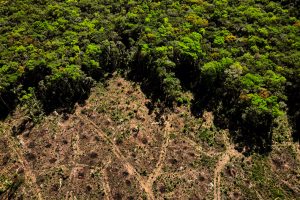
That slow pace of responses could have dire effects, not just for biodiversity, but also the world’s annual economic output.
Reefs, for instance, provide about $2.7 trillion in goods and services annually, according to a 2020 estimate by the Global Coral Reef Monitoring Network.
About $44 trillion of the world’s annual economic output – or roughly half the total – relies on the world’s natural resources and services, according to the World Economic Forum.
That includes $2.1 trillion in the United States, $2.4 trillion in the European Union and $2.7 trillion in China.
The World Bank estimates that the collapse of certain ecosystem services, such as fisheries or native forests, could cost the world economy $2.7 trillion annually by 2030, about 2.3% of global output.
Other items on the agenda
Among other things on the agenda at COP16 would be the inclusion and proper representation of Indigenous and traditional communities in the UN decision-making on biodiversity.
The summit also aims to establish a global multilateral system for paying for access to data on genetic information taken from plants, animals and microbes. The data, called digital sequence information (DSI), can be used in researching and developing new medications, cosmetics or other commercial compounds.
Another major area of focus will be shoring up biodiversity aid that has, so far, fallen short of the amounts pledged in 2022.
In 2022, governments provided about $15.4 billion to help developing countries meet their nature goals. That was up from $11.4 billion in 2021, according to the Organisation for Economic Co-operation and Development (OECD).
At COP15, wealthy nations agreed to up their contributions to at least $20 billion annually starting in 2025, with the target rising to $30 billion by 2030. Those pledges, however, are “pretty thin”, according to Brian O’Donnell of the Campaign for Nature advocacy group.
The UN Environmental Programme estimates spending on nature needs to increase to $542 billion annually by 2030, up from $200 billion as of 2022, to halt nature loss and meet climate goals.
In Cali, both governments and companies are expected to announce further funding efforts.
View this post on Instagram
- Reuters, with additional editing and inputs from Vishakha Saxena
Also read:
Scientists Fear Nature’s Carbon Sinks Are Failing – Guardian
Energy Emissions Set to Peak But ‘Not in Time’ For Climate Goals
Floods or Drought: Climate Change Worsens Global Water Woes
Forest Fires a Double Whammy for Climate Change Fight – Guardian
Furore Erupts After EC Agrees to Delay Forest Protection Rule
Pacific Islands Want ICC to Make Ecocide a Criminal Offence
Extreme Weather Cost China More Than $10 Billion In July Alone
Critical China Factory Hubs Face Greatest Climate Change Risk




